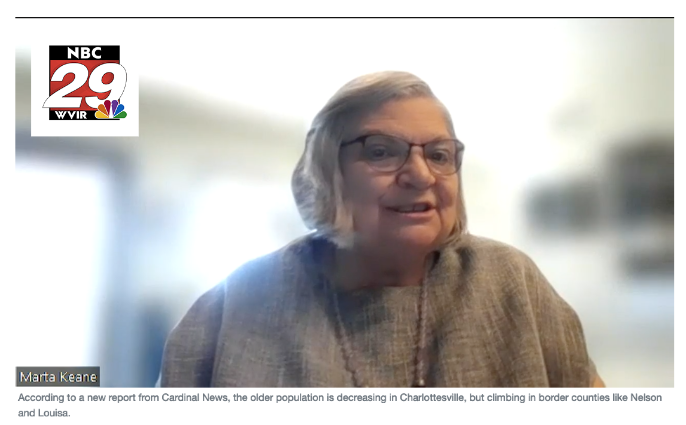Charlottesville's older population grew by less than 2 percent between 2000 and 2020 (and shrunk between 2000 and 2010) while it grew between 7 and 9 percent in surrounding counties.
In May 1963, when Older Americans Month was established, only 17 million Americans had reached their 65th birthday. Today, there are over 55.8 million Americans 65 and older. Between 2010 and 2020, according to the 2020 census, the number of people 65 and older increased by 15.5 million, the largest-ever increase in a decade, according to new analysis from the Census Bureau released last week (available below this article). The next largest increase, between 1980 and 1990, was less than half that number.
In Virginia, the percentage of those 65 and older went from 11.2 percent in 2000 to 16.2 percent in 2020, putting us near the bottom of the list, with states like Maine and Florida at more than 20 percent. In Charlottesville, Albemarle County, and our surrounding counties the older population has also increased a lot between 2000 and 2020, but the localities have their characteristics.
For example, Charlottesville's older population (how we'll refer to those 65 and older now) only grew from 10.1 percent in 2000 to 11.7 in 2020. And between 2000 and 2010 the older population actually decreased, from 10.1 percent to 9.2 percent. By comparison, Albemarle County's older population grew from 12.5 in 2000 to 19.4 in 2020. Likewise, Fluvanna, Greene, and Louisa counties saw increases between 7 and 8 percent in their older populations. Nelson County saw the largest increase, from 16.8 percent in 2000 to 28.9 percent in 2020.
So why such noticeably slow growth in Charlottesville's older population?
According to Hamilton Lombard, a demographer with UVA's Weldon Cooper Center, it's a pattern he's seen in other independent cities in Virginia, which had relatively larger older populations 20 or 30 years ago.
"In Charlottesville, the area neighborhoods around downtown were 25-30 percent over 65 in 1990," he says, " but today they are probably under 15 percent."
Lombard attributes much of that to neighborhood turnover.
"If you think about a neighborhood like Belmont, 30 years ago the residents were disproportionately over 65. As housing has turned over in many independent city neighborhoods, the new residents have tended to be young adults, often buying their first home or renting," he says.
He also attributes it to city boundaries being frozen with annexation moratoriums or in Charlottesville's case the revenue-sharing agreement.
"It meant that there was often little new housing being built for young couples, instead they moved to nearby counties," says Lombard. " Meanwhile, during the 1970s and 1980s, neighborhoods in many of Virginia's independent cities aged as many couples who had bought the homes when they were new in the 1950s-1970s stayed in those neighborhoods."
Lombard also says that many of those Baby Boomers who moved to suburbs in nearby counties have stayed in the homes they raised their children in. As a result, the neighborhood turnover that has occurred in the city isn't happening in the nearby counties. It's to be determined if the same kind of turnover dynamic will occur in the suburbs as the Baby Boomers get older, he says.
Meanwhile, housing built in the city in recent years has disproportionately been apartment complexes, says Lombard, which is more likely to attract younger people than older people.
"One way of thinking about the different age dynamics in Charlottesville and Albemarle is that the city is building relatively little housing that would be attractive to most people over 65," he says.
And by attractive, that would mean affordable for most older people, who are trying to figure out how to survive on set incomes for longer. Indeed, a recent study/survey from JABA showed there were three main factors causing seniors to leave Charlottesville: a lack of affordable housing, transportation, and social engagement, with an emphasis on affordable housing.
However, the census data also shows that older people and younger people may be in the same boat. Because the city also has relatively little housing that would be attractive to most younger people hoping to put down roots and raise a family, which is causing many young people to put those ideas on hold. As the new Census Bureau data released last week revealed, the homeownership rate is the lowest it’s been since 1970.
Nationally, the growth of people renting is continuing to outpace the growth of people buying, as it has since 2000, a trend that shows how homeownership is getting out of reach for more and more people. And among those buying, the racial disparity is still pretty glaring, with White homeownership rates at 70.5 percent, Asian homeownership rates at 58.5 percent, and Multiracial homeownership rates at 54.2 percent.
Meanwhile, as Lombard mentions, a drop in fertility rates across Virginia and the country shows that younger people are putting off having children.
"In a few years, unless births rebound," says Lombard. "I would expect the population under 18 to start declining in Virginia as a whole."
A version of this story first appeared in C-Ville Weekly’s GenNow special section.
2020 Census Bureau Aging Data and Analysis - May 2023
Census Bureau Releases New 2020 Census Data on Age, Sex, Race, Hispanic Origin, Households and Housing (includes excellent data highlights on age)
2020 Census: 1 in 6 People in the United States Were 65 and Over
Older Americans Month: May 2023 ( a huge collection of key stats and documents on aging)
An Aging U.S. Population With Fewer Children in 2020
Hispanic Population Is Younger But Aging Faster Than Non-Hispanic Population
Interactive Maps
Exploring Age Groups in the 2020 Census (can explore by States, Counties, and Tracts)
How Has Our Nation's Population Changed? (can explore by State, Metro area, Micro area, and County)






